Making a Web Comic: Drawing the Comic
by technosapien in Design > Art
97712 Views, 151 Favorites, 0 Comments
Making a Web Comic: Drawing the Comic
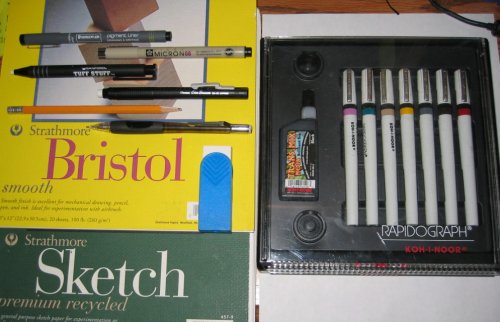
Update: August, 2019:
Hello, friends. I'd like to make a few small updates to the information below.
Twelve years later, technology and my process have changed. when I draw on paper, I no longer user black/grey graphite to draw, I use non-repro blue pencils (Prismacolor Col-Erase, which I buy by the dozen from Amazon), and when I do lettering on paper, I have started using an Ames lettering guide, also likely available at your favorite art or online retailer.
That said, pen tablet technology has advanced quite a lot in 12 years, and I have upgraded much of my process to digital using a Surface Pro 4 tablet and Clip Studio Paint software. I also recently obtained a used Wacom Cintiq which I am excited to add into my workflow soon. As time permits, I may add more info on my digital process or may create a new instructable entirely (unless the topic is saturated...).
Another process I may try out, which I gleaned from Dave Kellett of Sheldon Comics, is digital creation of the comic, printing it out and then lightboxing/inking over, to create a paper original which is then scanned, cleaned up, and published. Having the original for future use is superb if you want to sell originals. Useful for gag and one-off strips, less useful for story-based comics (few people will purchase an original page from a story, if the page makes no sense on its own, but gag strips tend to work well).
Thanks for reading!
---
Good day, and welcome to the first of what I hope to be many tutorials I can help provide for those budding graphic artists and comic creators that want to learn how to make and share good-looking comics.
First off, I'd like to say that I wouldn't be the obscure but capable webcomic creator I am if it weren't for a whole slew of artists before me. My comic, HOSERS: The Comic Strip was inspired by my personal faves of the early greats of webcomicdom, primarily GOATS: The Comic Strip, GPF Comics, College Roomies From Hell!!!, and Nukees!. Thank you, Jon, Jeff, Maritza and Gav. As always I must tip my hat to you and your dedication to the art.
Second, anyone really interested in creating comics should pick up and read two or three of Scott McCloud's books: Understanding Comics, Reinventing Comics, and Making Comics. All are available from Amazon.com or you local bookstore. McCloud is very astute and has great suggestions on putting together a comic. If you read only two, you can omit "Reinventing Comics" -- but really, you should read all three. Also for good practice on framing comic strip panels, try out Wally Wood's 22 Panels That Always Work.
UPDATE: In addition to the books and sites above, you should also purchase and read the excellent How to Make Webcomics by Brad Guigar, Dave Kellett, Scott Kurz, and Kris Straub. It is an excellent book and I highly recommend it.
Anyway, this instructable will deal with the useful mechanics of webcomics production, in my opinion: how to sketch and ink your comic on paper. I plan a future instructable about how to make it into a nice-looking image for web - and possibly print - presentation. (Coming Soon!)
The process I use cribs parts from a dozen other webcomic processes, and of course doesn't apply to work drawn entirely on the computer, say using a tablet. I do that also, and will create a separate instructable for my fully-digital production methods if someone would like to see one.
So let's get started! For this tutorial, I am going to draw a comic strip. Well, don't act so surprised....
Drawing the Comic: Supplies

I use Strathmore paper when preparing my images. I have a sketchbook I use to plan all of my comics, and the final images are drawn on Bristol Smooth paper, 9"x12". The Bristol board really holds the ink well.
(Note: some artists just us printer paper, and if this works for you, that's fine. However I have comics drawn on printer paper and with sharpie markers that have noticeably not withstood the test of time over the past 8 years, while images made with the Strathmore paper and the pens noted below are still as clear as the day they were drawn.)
I have a full compliment of artist's pencils but most of my sketching is done with .5mm and .7mm mechanical pencils or a #2 yellow pencil. I erase the lines anyway. Many artists use non-repro blue pencils so they don't have to erase. I've tried this, too, but I don't buy non-repro blue pencils because they're expensive. There's really no "official" color known as "non-repro blue" to my knowledge. Any hard-lead light-blue colored pencil does the same job, for much less. Modern scanners and software are pretty good at ignoring the pale blue lineart regardless what instrument was used to draw them. You can also use light green or yellow.
My eraser of choice is a white plastic Staedtler eraser. It does a great job lifting the pencil from the paper without removing any ink at all. For detail erasing I use a Pentel ClicEraser, it also uses the white plastic type of eraser material. I know people who swear by kneaded erasers. Personally, I don't like them. Pink erasers are too rough on the paper and can cause the paper to fray, and then have trouble holding ink properly later on.
My pens of choice are a set of Koh-I-Noor Rapidograph technical pens. They're anywhere from a little pricey to exorbitant depending on where you buy them and if they're on sale... and the really fine-line pens need to be used often or drained out, otherwise the ink dries in them and turns them into expensive darts. Many webcomic artists prefer a nice set of disposable Pigma Micron pens or Staedtler Pigment Liner pens, which have archival-quality ink in them and so shouldn't fade even after many years. I started with these, and occasionally use them when I travel (I don't travel with the Rapidographs). For coloring by hand (which I'm not covering here) you have dozens of options. Colored pencils, watercolors, and markers seem to be the most popular choices, but this is really a personal decision. Try them all and pick what you like. I usually color digitally, which will be covered in an upcoming tutorial.
(Note: as I mentioned above, I've seen people use sharpie markers to do the artwork. I've done this myself. Sharpies however are not archival quality ink, and do not stand up to the ravages of age. I also find that even on high-quality paper, the lines they leave behind look sloppy. If you want your images to last a long time and look crisp, use a pen that contains archival ink. They're not much more expensive than sharpies, and they'll look better.)
I don't use white-out or white liners to fix mistakes, because I can do that on the computer. When I work with all of my artist pencils, erasers fix mistakes. When I use charcoal, kneaded erasers are actually useful here. When I use colored pencils... well, try not to make mistakes. I haven't found anything good for that yet.
Update: As mentioned above, I now use Prisma Col-erase Nonrepro Blue pencils to do my penciling. These are much cleaner to work with, and require less erasing. They don't need to be removed for scanning, just lightened, and scanning in at B/W in later steps, you can tweak the scan settings to perfectly eliminate the blue lines (the benefit of using a "non-repro" blue pencil).
For lettering by hand, I highly recommend investing in an Ames lettering guide and looking up a few videos on how to use it, but I will add some info to this tutorial eventually. It's the tool the pros use to keep their hand-lettering aligned.
Drawing the Comic: Sketch and Layout
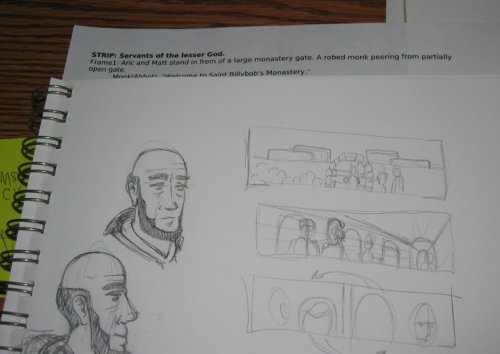
The first step is to review the script for the comic, and start sketching the layout. Some comics are simple 4-panel presentations that never vary, and for those all you're planning is the location of images and words within each panel. This is sometimes called "storyboarding."
For more complex comics, you will actually be planning the size, shape, and positioning of the panels themselves as well as the layout of images within the panels. Some useful info on panel layout can be found at Peter Venables' 22 Little Panels site, which contains information about Wally Wood's 22 panels that always work. I just found this myself recently, so I have yet to start implementing all of these ideas in my comics.
Another thing I do at this point is to sketch at least one good sketch of my "regular" characters who will appear in the strip. In this storyline their appearances change a little each time so I want to make sure I'm staying consistent. Also it helps to practice. I will also work out detailed sketches for the incidental characters who will appear in more than one strip, and who may at some point re-appear in the future.
Drawing the Comic: Panel Layout
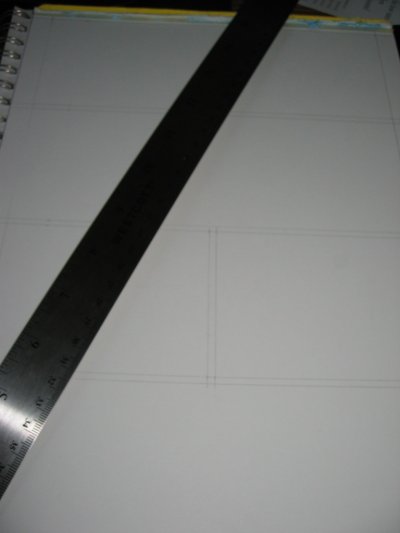
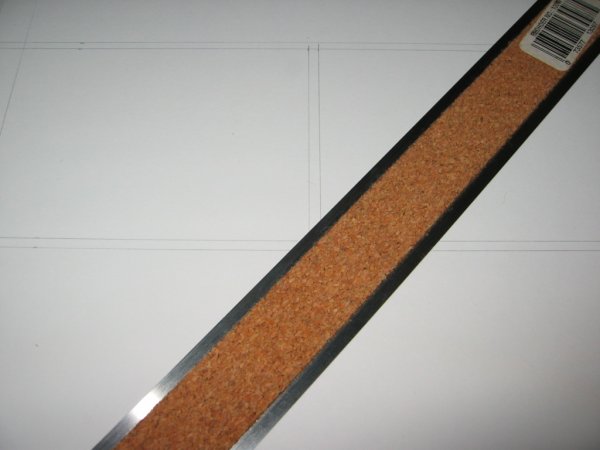
When I'm done with the sketches I take an 18" Wescott metal ruler with a cork backing, and measure out the panels for the comic onto my Bristol board with light pencil lines. Always pencil, in case you mess up. You can't really see it, but I had to erase 6 lines from this page before getting the layout right. In the next step I actually change the panel layout on-the-fly. This is why pencils are your friends. Some comic creators will draw their frames in ink immediately, but I can't constrain myself at this step. I change things too often.
Since I try to keep comics drawn on paper confined to a single page, I usually leave 1/2 inch margins around the panels. However because I needed more room for this particular layout, the margins are 1/8" top and bottom, and 1/4" on the sides. This actually will make it slightly harder for me to draw the comic, but I really need the space. I could split these up onto two pages, but I feel like I'm wasting too much paper doing that.
I use 1/8" gutters -- the space/gap between panels.
Drawing the Comic: Dialogue
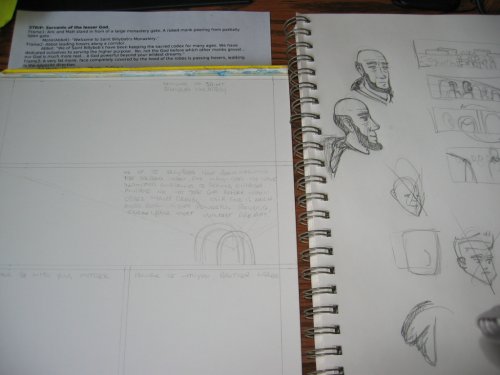
So this is where I do things a little backwards from most comic artists. Because my comics tend to be a little heavy on dialog, I like to plan the placement of text first so that I am not forced later to cover any of the artwork with word balloons. I generally will hand-letter my comics, but sometimes if my handwriting is particularly bad I'll replace it with a lettering font. More on that in Part 2.
(Sorry for the image quality....)
In panel two, you can see I've sketched in some artwork. I wanted to make sure the text placement I chose would not obscure anything important, so I had to jump ahead a little to....
Drawing the Comic: Pencil Sketch
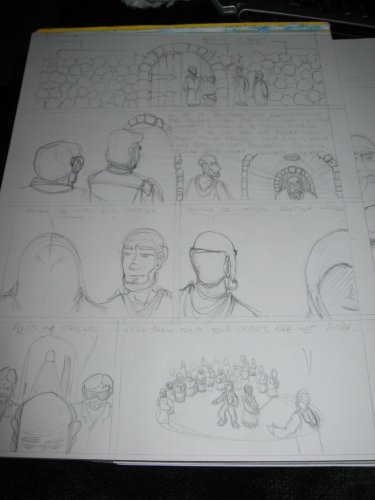
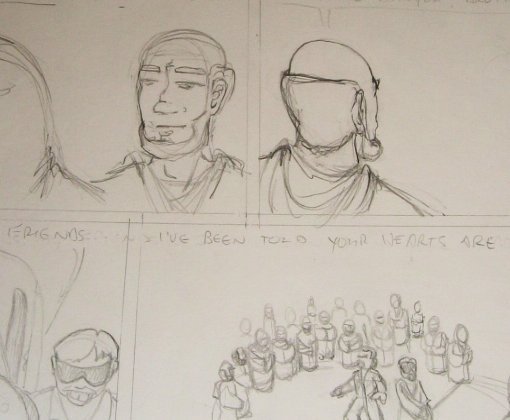
... pencil sketching. The key is, same with lettering, to keep the pencil lines as light as possible. You don't want to create "dents" in the paper, since this makes it harder to correct lines that are wrong. Even if you can erase the line, the dent is left behind and the pen may get stuck in it. Also if you opt to color your images with artists' pencils, charcoal, or colored pencil, these media will skip over the dents leaving behind "ghost" lines of your original sketch. These can be dealt with but it's a real pain in the rear!
Sketching for me goes in waves. I'll re-create as close as I can the light sketches from my spiral-bound sketchbook to ensure the layout is correct. I'll go back with the same pencil and draw slightly darker lines to define the final lines, which will become the guides for inking the image. That's the next step.
Drawing the Comic: Inking (I AM NOT a TRACER)

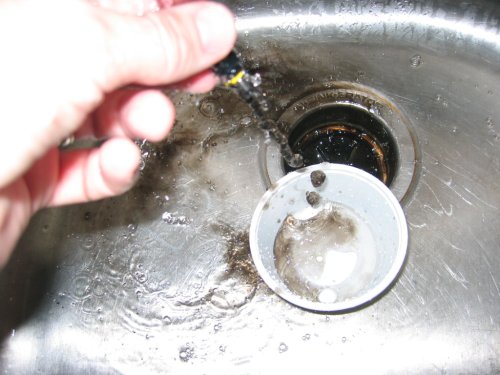
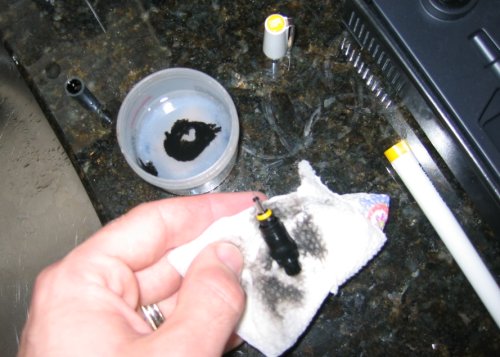
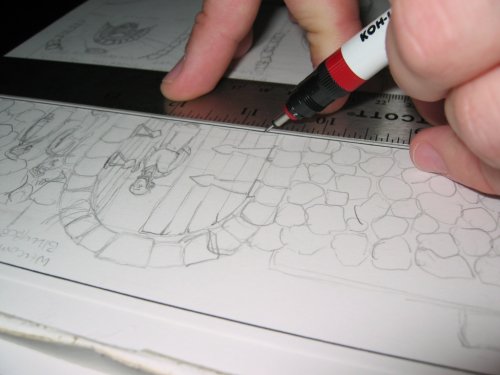
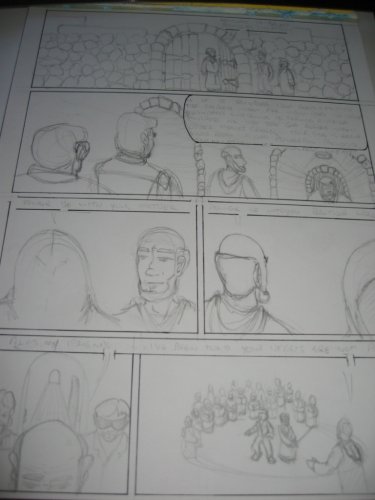
I'm an INKER!
I take out my metal ruler and break out the Rapidographs. Unfortunately, I haven't used them in a while so I have to take them apart, soak the tips, clean them out, and refill the ink wells. If you choose to get this kind of refillable technical pen, remember to use them often - at least weekly - or clean the ink out of the nibs before you store them. The ink can congeal inside the tips and the pin that controls the ink flow can break. this is a problem especially with the really fine liners.
Once I've reassembled my pens and gotten them working, I take my widest pen and use the ruler to draw the frame containers. This is where the cork backing on the ruler is important. Because it lifts the edge of the ruler off the paper, the ink will not soak under the edge of the ruler via capillary action and ruin your lines. This is important - do not run ink pens of ANY kind along the edge of a ruler that sits flush on the paper. The ink will soak under the ruler, and you will probably get smudged lines when you move the ruler away form the paper. It can be fixed, but better not to have to deal with it.
In some places I won't draw the lines completely to the corner of a frame, and I'll freehand in curved corners where word balloons will actually be flush with the border of the frame. I just like the way it looks.
I'll also often ink in the word balloons at this point. Sometimes I'll wait until I'm done lettering to do that, but today I'm going to be confident in my lettering, and ink the word balloons now.
When I'm done drawing the frames and word balloons, I'll go in and do the lettering.
Drawing the Comic: Lettering (and Word Ballooning)
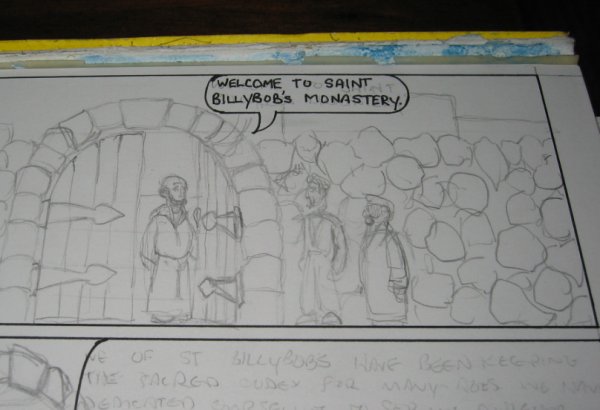
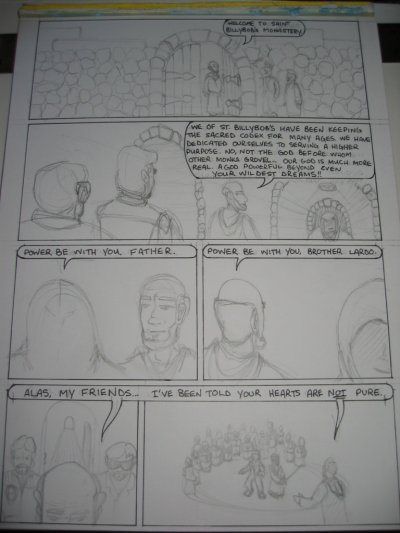
There's an art form to lettering and word-ballooning, and whole theories dedicated to them. I am not a very good letterer, so I can't explain any of these theories to you. I just do it. If you want more info on lettering, do a Google search or read up in Making comics. It's all there.
I letter the comic with the thickest pen I can get away with. I try my best to make sure my letters are even, straight, and distinct (D and O can be told apart, I and T, etcetera).
When the lettering is done, if I have not already done so, I'll use my ruler and thickest pen to draw in any word balloons. I use the ruler for straight sections of balloon lines, and freehand the curved lines.
If I know I am going to use a digital font to letter the comics, I may skip this step. however I personally consider it cheating, and much prefer the look of hand-lettering even if it's a little bit bad.
NOTE: It is NOT cheating if someone ELSE does digital lettering. I only hold myself to that rule, anyone else is free to do as they wish, and I do not criticize or judge against them.
I normally pick a section of the paper to write in my name, my co-author's name, the name of the studio, and the date of the comic. I didn't do that here because I don't have enough room on this page, and I don't know what date I expect to publish this comic right now. I'll add these details in the second part of this tutorial, when I do the digital image manipulation to prepare the comic for publication.
Drawing the Comic: the Artwork
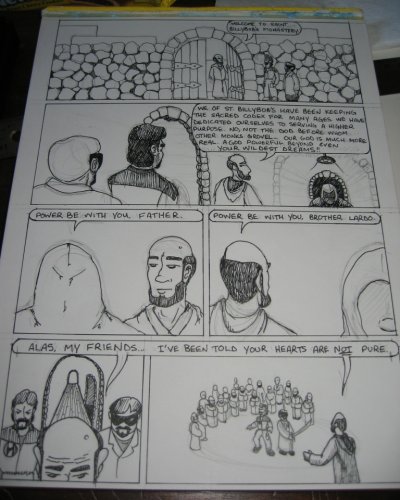
The next step is to use the various thickness pens I have to complete the inking. I'll usually draw items in the foreground first and with thicker lines than items further in the background. I use the thickest pen I can get away with to draw any particular detail. For close-up images I can use thick pens for outlines and thinner lines for detail work. Items or scenes which are more distant, or less-intricate have to be done with thinner pens. I'll generally use 3 pen thicknesses in a single page, no more or it becomes too much work.
(But I will at least try to use every pen to keep the ink flowing and the tips clean, even if it means doing some doodling in my sketchbook.)
Drawing the Comic: Erasing and Final Touches
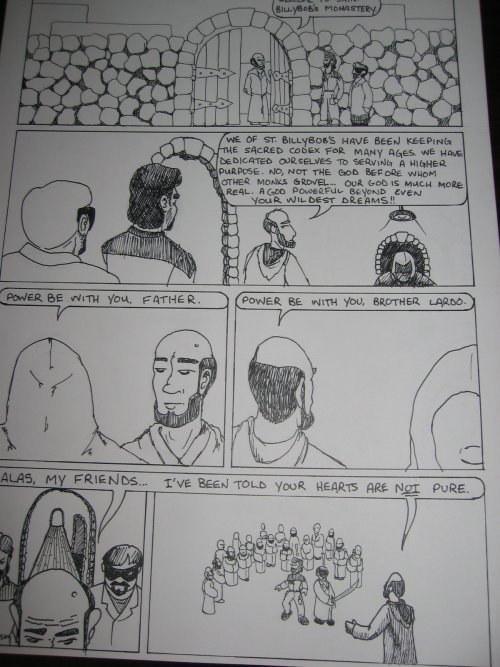
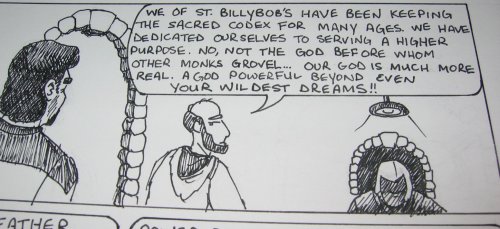
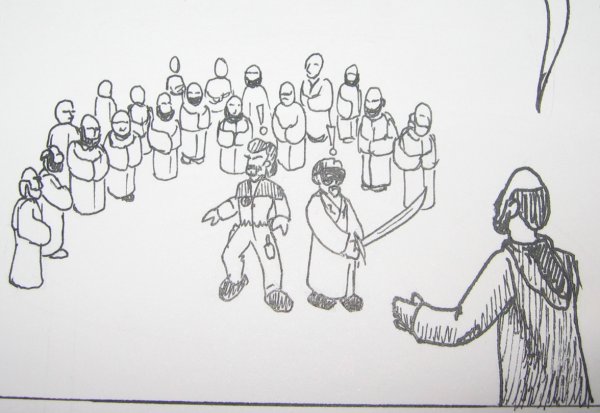
When all that inking is done, I'll let the paper sit for an hour. Or, several days. Yes, I'm paranoid, but I've had a bad experience with this in the past, being too impatient. Because next, I use the large plastic eraser to remove all the pencil lines. If the ink isn't dry, you will create shredder-bait. Also, it messes up the eraser.
When the pencil is all erased, I get a first look at my final inked image. I examine the artwork closely, and go back in with the pens to clean up any lines I missed, close up any areas that need to be closed, and add in any additional detail work I feel the image needs.
At this point, many artists will do a lot more work by hand, especially coloring the artwork in. I've used colored pencils and various artist's pencils in the past to do special work like this, but lately I do most of my coloring and touch-up on the computer.
Thank you, and stay tuned for an upcoming tutorial, which will be dedicated to explaining a process for scanning the image and editing the image in the Linux operating system using free, open-source software -- perfect for the webcomic creator on a budget.